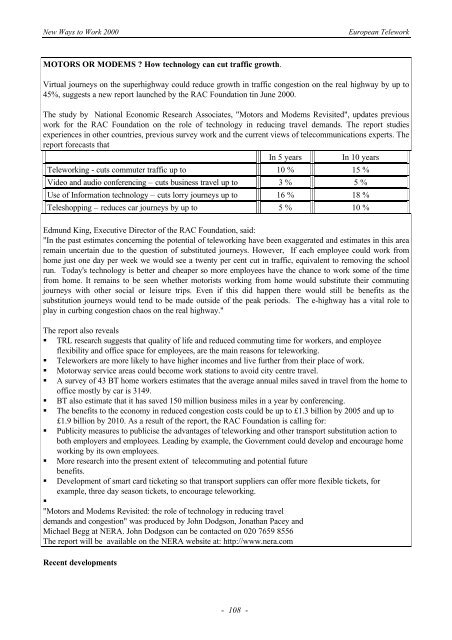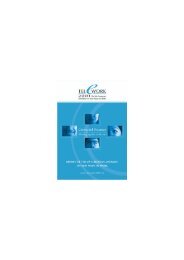eWORK 2000 - European Telework Week
eWORK 2000 - European Telework Week
eWORK 2000 - European Telework Week
- No tags were found...
Create successful ePaper yourself
Turn your PDF publications into a flip-book with our unique Google optimized e-Paper software.
New Ways to Work <strong>2000</strong><strong>European</strong> <strong>Telework</strong>MOTORS OR MODEMS ? How technology can cut traffic growth.Virtual journeys on the superhighway could reduce growth in traffic congestion on the real highway by up to45%, suggests a new report launched by the RAC Foundation tin June <strong>2000</strong>.The study by National Economic Research Associates, "Motors and Modems Revisited", updates previouswork for the RAC Foundation on the role of technology in reducing travel demands. The report studiesexperiences in other countries, previous survey work and the current views of telecommunications experts. Thereport forecasts thatIn 5 yearsIn 10 years<strong>Telework</strong>ing - cuts commuter traffic up to 10 % 15 %Video and audio conferencing – cuts business travel up to 3 % 5 %Use of Information technology – cuts lorry journeys up to 16 % 18 %Teleshopping – reduces car journeys by up to 5 % 10 %Edmund King, Executive Director of the RAC Foundation, said:"In the past estimates concerning the potential of teleworking have been exaggerated and estimates in this arearemain uncertain due to the question of substituted journeys. However, If each employee could work fromhome just one day per week we would see a twenty per cent cut in traffic, equivalent to removing the schoolrun. Today's technology is better and cheaper so more employees have the chance to work some of the timefrom home. It remains to be seen whether motorists working from home would substitute their commutingjourneys with other social or leisure trips. Even if this did happen there would still be benefits as thesubstitution journeys would tend to be made outside of the peak periods. The e-highway has a vital role toplay in curbing congestion chaos on the real highway."The report also reveals• TRL research suggests that quality of life and reduced commuting time for workers, and employeeflexibility and office space for employees, are the main reasons for teleworking.• <strong>Telework</strong>ers are more likely to have higher incomes and live further from their place of work.• Motorway service areas could become work stations to avoid city centre travel.• A survey of 43 BT home workers estimates that the average annual miles saved in travel from the home tooffice mostly by car is 3149.• BT also estimate that it has saved 150 million business miles in a year by conferencing.• The benefits to the economy in reduced congestion costs could be up to £1.3 billion by 2005 and up to£1.9 billion by 2010. As a result of the report, the RAC Foundation is calling for:• Publicity measures to publicise the advantages of teleworking and other transport substitution action toboth employers and employees. Leading by example, the Government could develop and encourage homeworking by its own employees.• More research into the present extent of telecommuting and potential futurebenefits.• Development of smart card ticketing so that transport suppliers can offer more flexible tickets, forexample, three day season tickets, to encourage teleworking.•"Motors and Modems Revisited: the role of technology in reducing traveldemands and congestion" was produced by John Dodgson, Jonathan Pacey andMichael Begg at NERA. John Dodgson can be contacted on 020 7659 8556The report will be available on the NERA website at: http://www.nera.comRecent developments- 108 -








